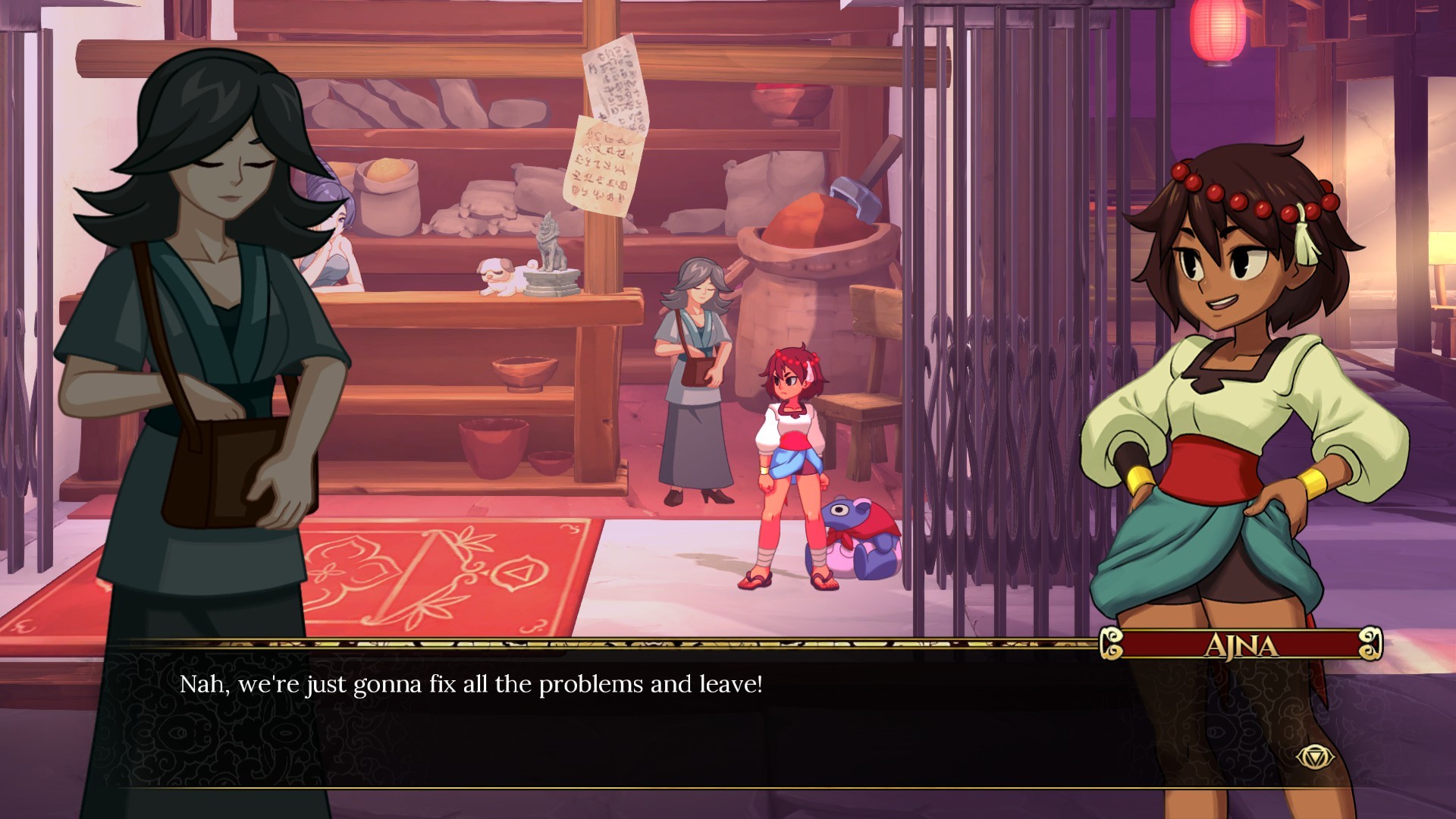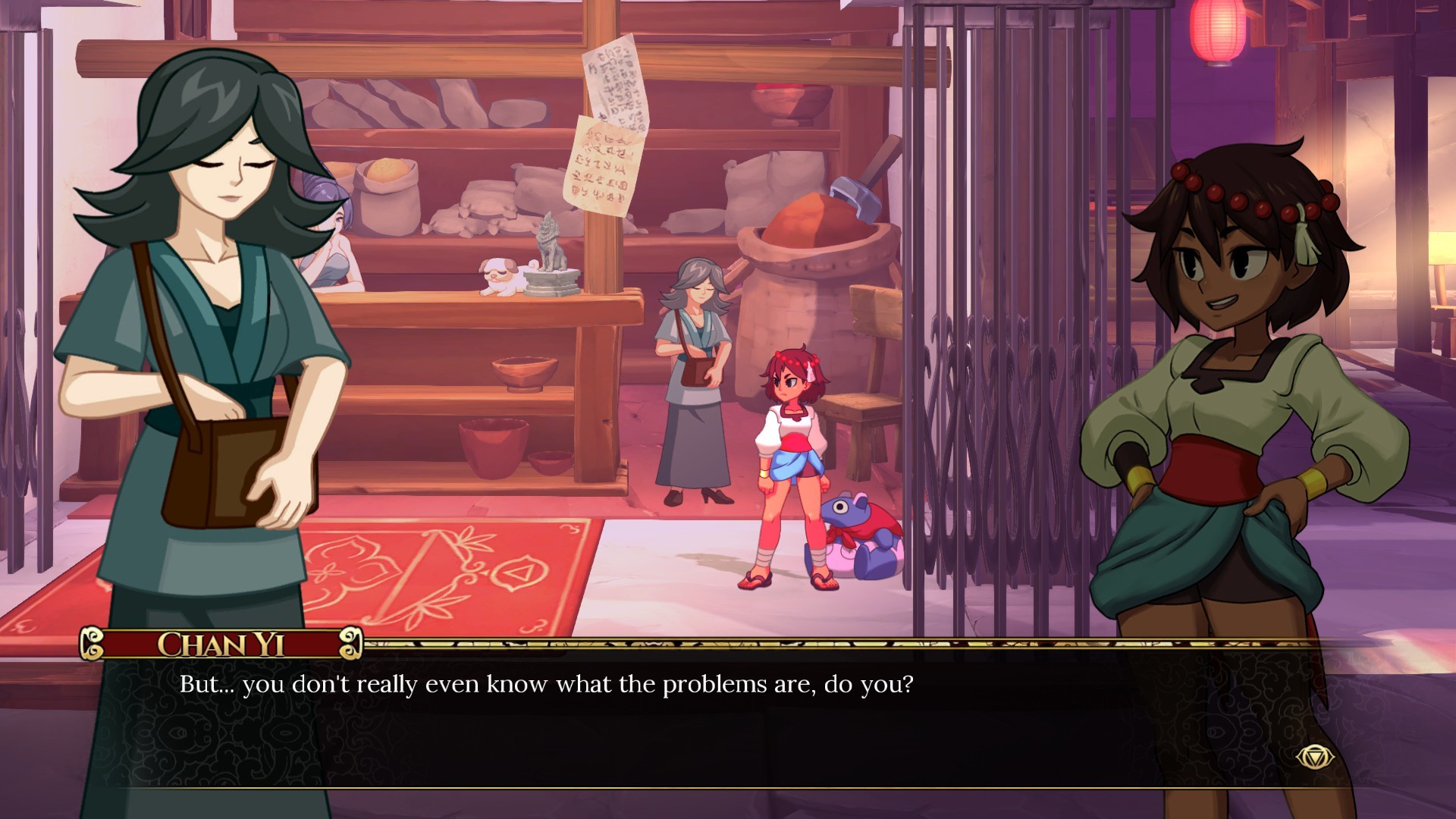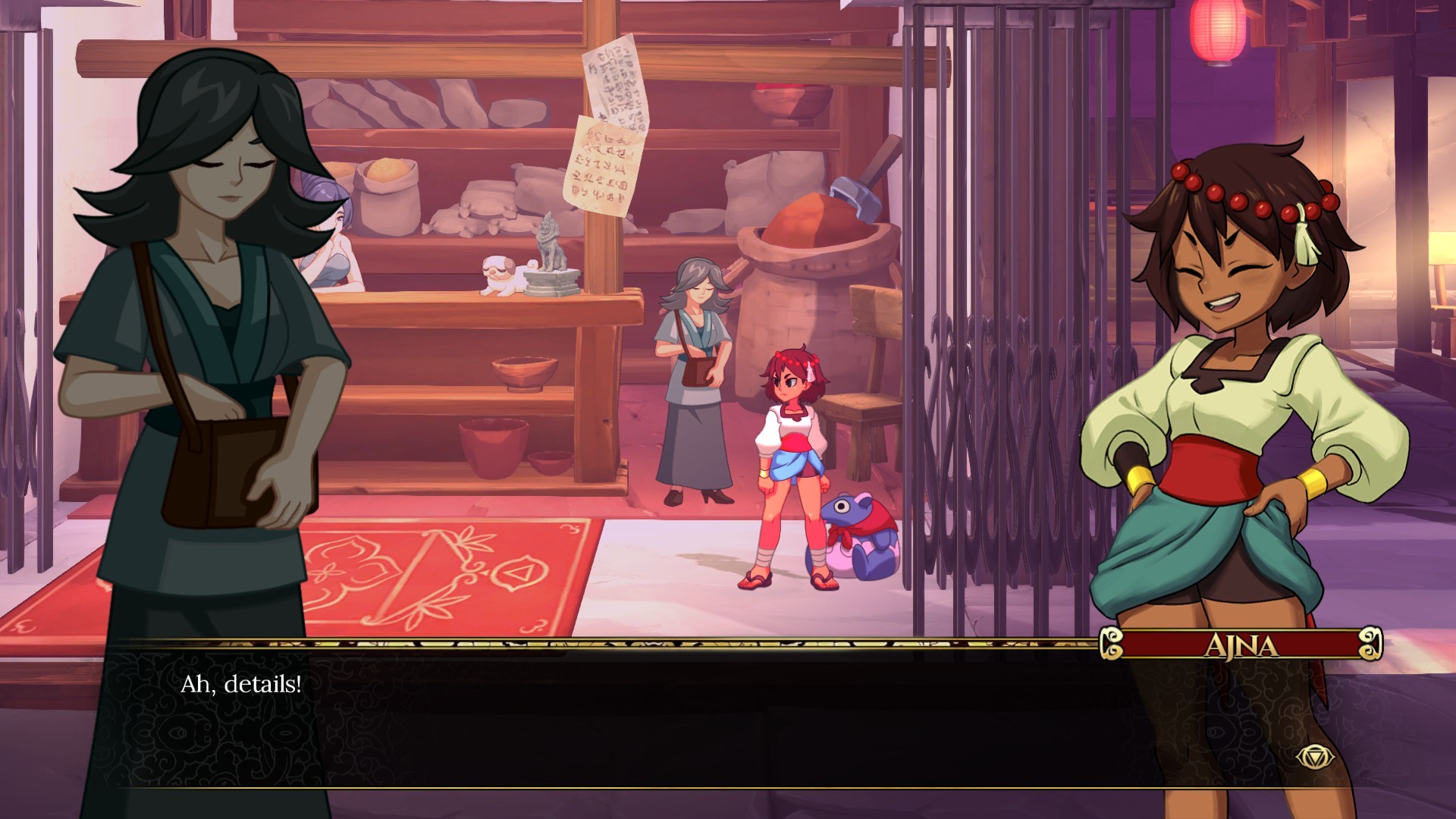Like Valkyrie Profile, but with Buddha instead of Odin
Every time I tell someone that "Indivisible is kinda like Valkyrie Profile," they respond with a shrug -- which is more than fair, since I've barely played Valkyrie Profile myself. And like I said back in 2011 - about a game released in 1999 - surprisingly, not many titles have tried to imitate it.
So to put it another way: Indivisible is a side-scrolling action-RPG with real-time multi-character combat, platforming challenges in a Metroidvania-like interconnected world, a plot inspired by Southeast Asian mythology, and a large cast of unique characters who by the way accompany the protagonist Ajna by living inside of her head. Does ... does that clarify things?
Combat is Indivisible's most distinctive aspect. If you aren't familiar with Valkyrie Profile, the Mario & Luigi games might be the next best comparison: your party has four members, and each one is mapped to a face button on the controller. Pressing a character's button will order that character to attack, or if an enemy is currently attacking, will order your character to defend. Each character also has modified attacks when you hold Up, Down, or Left/Right while pressing their corresponding button.
Indivisible's combat is all real-time, so if the action meters are full, you could mash all four buttons at once to have the whole party attack together. A shared iddhi meter encourages you to defend sparingly, and timely defenses are rewarded with a little healing. (The iddhi meter can also be used by some characters for ultra-powerful super attacks.)
Where it gets really interesting is that, of Indivisible's dozens-strong cast, each character has a totally unique set of moves. Some can heal, some have projectiles, some use elemental effects, some deal damage to multiple targets, some launch enemies into the air or can pierce their defenses... some lay traps, or have delayed effects like charging up a later attack.
Indivisible isn't a "fighting game," but you can tell that Lab Zero's fighter background helped in building this system up. Each character's move-set feels uniquely tailored to their fighting style. For example, there's a dog, and he does damage by barking. You can also build your iddhi meter by petting the dog. (Aww.)
Outside of combat, Indivisible is a platform-puzzle-y Metroidvania: the main story will take you through a huge interconnected map of varied environments, and as you make progress and learn new abilities, you'll be able to unlock new areas or uncover new secrets in previously-visited locations. Sometimes these progress gates are pretty direct, i.e. you need an ability to open a door; and sometimes they're indirect, i.e. you need an ability to increase your aerial range in order to reach a platform.
Indivisible's bar for platforming skill is higher than most Metroidvanias, and its collection of abilities also becomes rather large by the end, making it a challenge (at least for me) to maintain the mapping of abilities to hand muscles. In most cases, this feels more like an opportunity to improve than like an annoyance, as the game provides plenty of helpful hints and is merciful with its checkpoints.
The exceptions are the trips to Mt. Sumeru, which are kinda bullshit. These gauntlet-style platforming segments are what I might expect from a platform game's "challenge mode," requiring planning and precision on par with a Mario endgame, except that Indivisible requires getting through these sections to continue with its story. Which made me very motivated, but not very happy.
But I digress. Overall, Indivisible's platforming chops are pretty damn respectable, and contribute to a healthy variety of gameplay along with the combat.
As for the interconnected map, it's pretty good, but lacks a bit of polish. Chiefly: you can never see the "whole" map at once. Every region of the world is connected, including by some means of fast-travel, but when you View Map you can only see the region you're currently in. Which is just fine for chasing a local quest, but unhelpful when trying to find a good route to another region.
Sidequests in the late game require quite a bit of inter-region travel, and I didn't really feel like I had a handle on all the available routes until I'd finished most of those quests.
It helps, though, that each region of the world has a distinctive theme and feel. And, even more, that these regional themes aren't your typical tropey videogame environments. Port Maerifa is a bustling Mediterranean-style trading post; Tai Krung City is a dense, neon-soaked Asian metropolis mixing nightclubs and ramen shops; Kaanul is reminiscent of Maya or Inca temples overgrown by jungle. And while the Iron Kingdom is a clear nod to European culture, its industrial-age setting throws away archetypal nobles/castles/crumpets in favor of Dickensian peasants/slums/malaise.
These regions and the NPCs inhabiting them are built around a world mythology cribbed from Buddhism and Hinduism, which are similarly under-utilized in videogames, resulting in a pretty refreshing plot. And Indivisible's ending is an especially great example of integrating that background mythos with its hero's journey,
More than its freshness and gravitas, Indivisible's storytelling is remarkable for how good-humored it is. Interactions with NPCs are almost always punctuated by a joke, and for all the problem-solving and world-saving that Ajna gets into, it's clear that "having fun" is still one of her top priorities.



Most of the (again, dozens-strong) cast is written with distinct and endearing personalities, and while some of the voice acting is ... let's say uneven, it's good when it counts. Crucially, Ajna's voice acting is some of the best I've heard in any game, and her emotional line deliveries are a big part of what makes Ajna's character development so compelling.
What did I miss? Oh, the rest of the audio is solid - including some catchy background tunes that I'm sure to catch myself idly humming - and the graphics are mostly excellent. These guys are known for their striking character art and fluid animations, and Indivisible's playable characters get top marks in both of those categories. Then there are the background NPCs made up for crowdfunding backers, which ... are easy enough to ignore.
Indivisible's imperfections - confusing world navigation, and the ass-ache that is Mt. Sumeru - were just enough to keep me from calling it an unconditional success. But it delivers strong on its core gameplay mechanics, builds a unique and refreshing world, and tells an interesting story; and for a studio's first attempt at an RPG, that's really damn good.
Better than: Timespinner
Not as good as: Bloodstained: Ritual of the Night
Whatever story-based game Lab Zero makes next: sign me up.
Progress: 100%, except the secret ... cat boss?